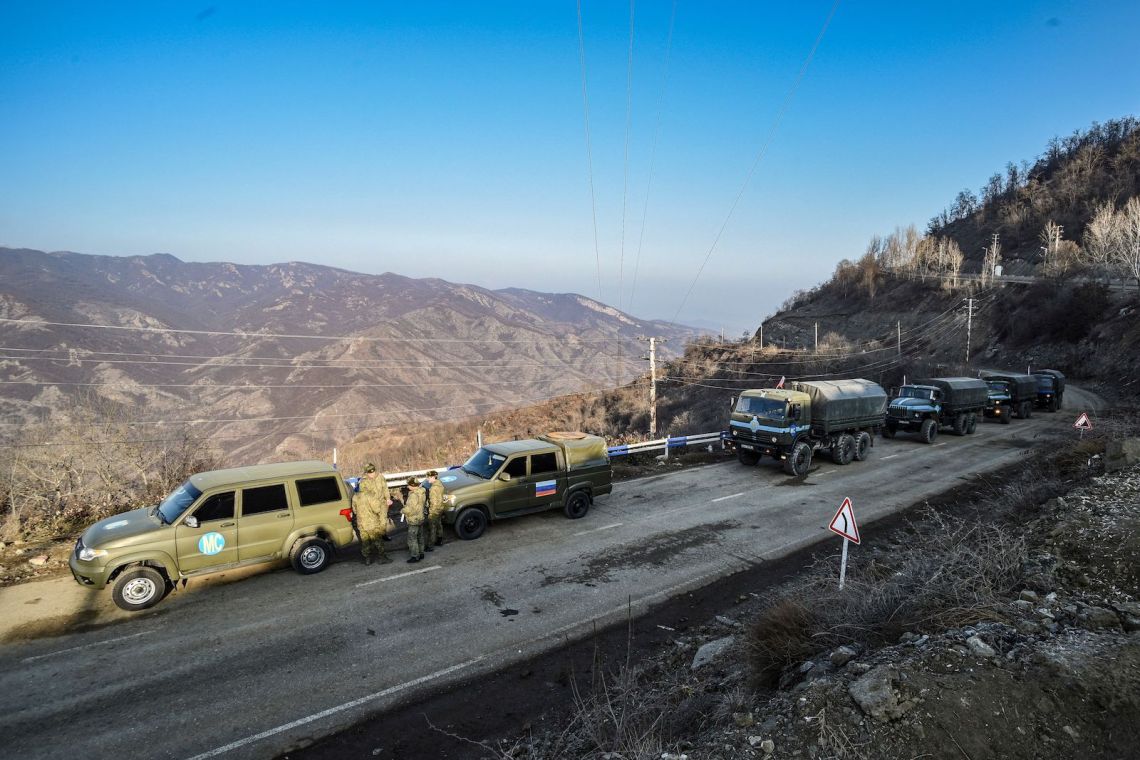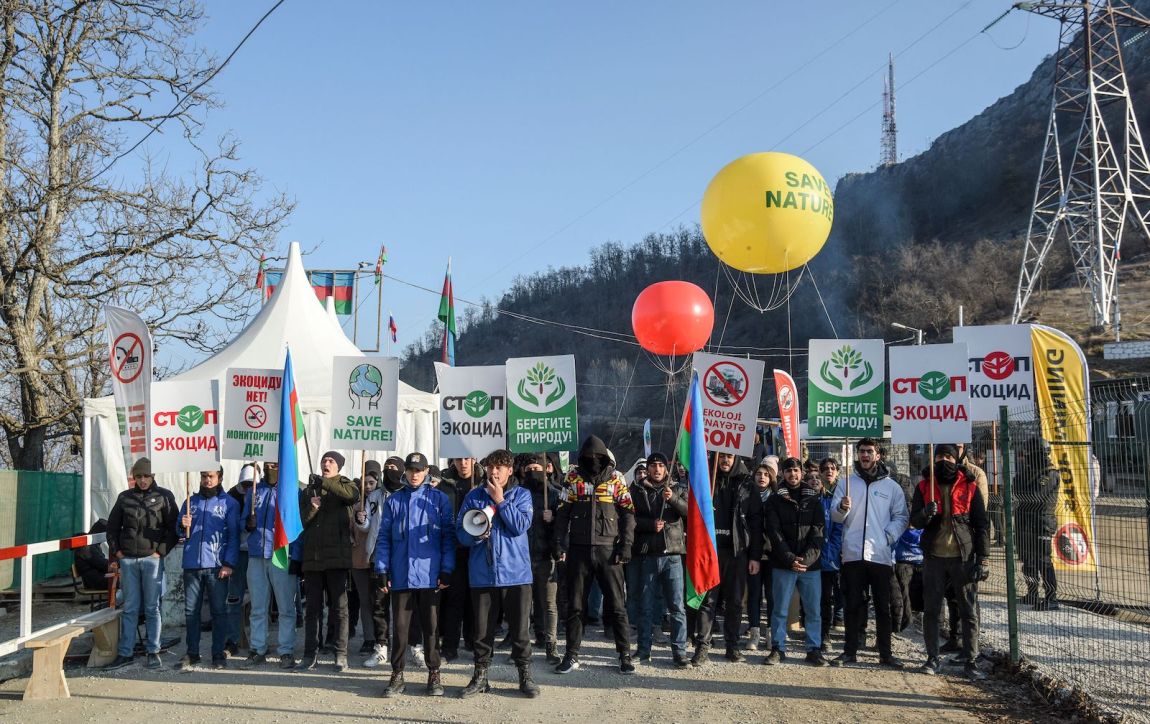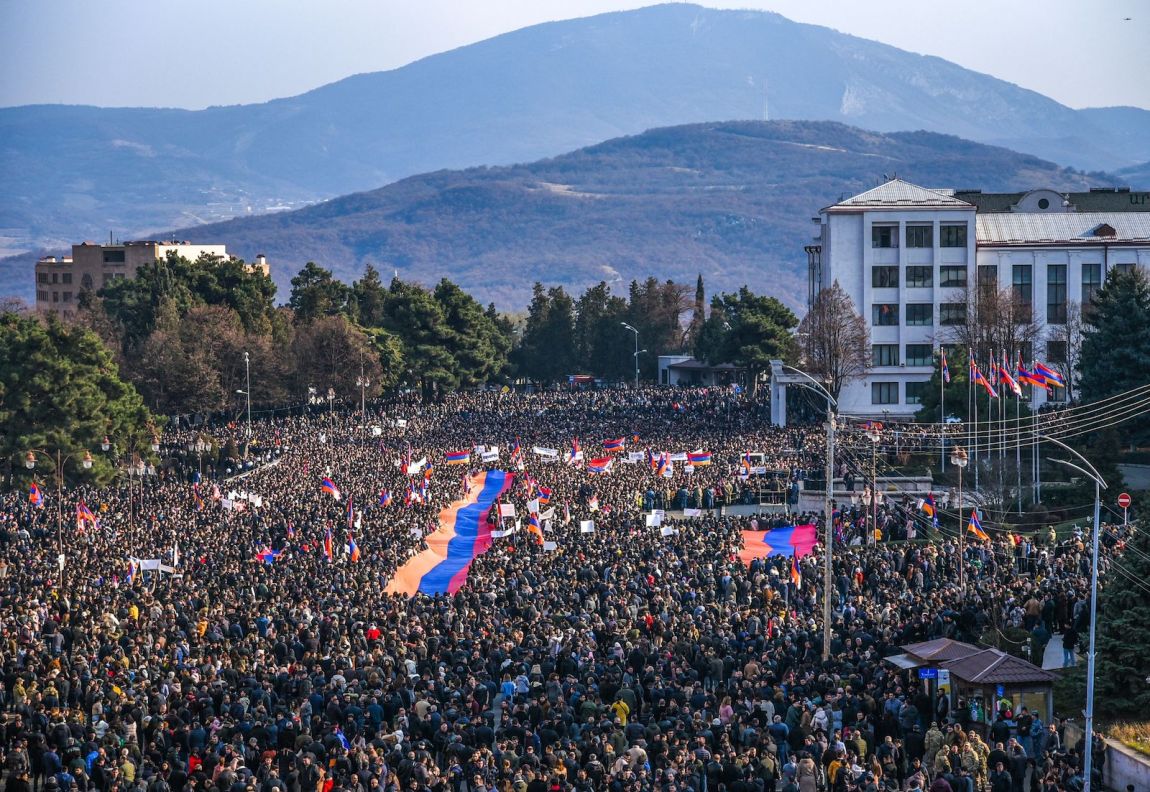There’s an old joke about a turtle being mugged by a gang of snails. When asked to describe the attackers, the turtle says he’s not sure, it all happened so fast. Blockades warp time in a similar way: the pain they inflict is both immediate and protracted.
Today is the seventy-third day of the blockade of the Lachin corridor, the only road that connects the Armenian-majority enclave of Nagorno-Karabakh with Armenia and the rest of the world. Nagorno-Karabakh is bordered on all sides by Azerbaijan, which initiated a war against the enclave in 2020 that ended with a Russian-brokered ceasefire. Now the 120,000 ethnic Armenians who live there are entirely isolated, prohibited from passing freely into or out of the region, and denied access to food, fuel, and medical supplies. The blockade is a violation of international humanitarian law by Azerbaijan and an act of aggression against the Armenians of Nagorno-Karabakh. The International Court of Justice ruled today that under the International Convention on the Elimination of All Forms of Racial Discrimination, Azerbaijan must “ensure unimpeded movement” through the corridor. The ruling comes after more than two months of quietly mounting suffering.
It started on December 12, 2022, when Azerbaijani government-backed demonstrators claiming to be environmental activists blocked the road with a protest against the mining of natural resources in the region. (Azerbaijan is still denying responsibility.) Russian peacekeepers charged with protecting the corridor made no attempt to disperse the demonstrators. The next day, Azerbaijan cut off the natural gas supply to Nagorno-Karabakh, leaving the blockaded population without heat in the middle of winter. Since then, none of the trucks that travel the Goris-Stepanakert highway daily with four hundred tons of essential goods have been allowed entry into the region. The International Committee of the Red Cross has been afforded only minimal access; as of February 1, they had made eighteen medical evacuations and several deliveries totaling ten tons of baby formula, food, and medical supplies. Meanwhile the Russian peacekeepers’ armored vehicles and personnel continue to shield the Azerbaijani demonstrators and the Armenian population from each other, in the process effectively forming a barricade of their own.
Deprivation has become the daily reality for people in Nagorno-Karabakh, or Artsakh, as Armenians refer to the enclave. On January 17 the government began issuing ration cards for dry goods. Nina Shahverdyan, who works for Teach for Armenia in the village of Herher, said that because schools are without heat, teachers are holding classes in their homes, where some have wood stoves. Her colleague Ashot Gabrielyan observed that while the scarcity of goods is a problem, the bigger problem is the violation of human rights. About 1,500 people, 270 of whom are children, are being denied freedom of movement, forcibly separated from their families on either side of the border as well as from their homes and workplaces. “This is the thing about the blockade,” Gabrielyan said, “it deprives us of the opportunities that you should have in the twenty-first century.”
I spoke with Gohar Abrahamyan, a twenty-eight-year-old scholarship coordinator for the Armenian Educational Foundation who lives in Armenia’s capital city, Yerevan. Her parents live in Artsakh. They are proud and optimistic; they rebuilt their house, which was destroyed in the 2020 war, and “they believe that everything will be ok.” But Abrahamyan is worried. The day we spoke, her family had gone without electricity for eight hours. “That means that you can’t heat your home, you can’t watch TV or have an Internet connection. Even cell phones don’t work because the stations are not working. It’s very hard psychologically for people.”
The human rights scholar Alex de Waal wrote in these pages last year about tactics of war that cause modern famines: “The beauty of blockades and sanctions, from the enforcers’ perspective, is that they are tools of bureaucratic regulation rather than displays of raw violence. The most favorable interpretation is that a well-run blockade is a measure short of war.” This hybrid measure is a tactic to put pressure on the Nagorno-Karabakh government and make life in the region unlivable, contributing to Azerbaijan’s ongoing military campaign to drive Armenians from their lands, or worse. “The future for Armenians living in Artsakh is unstable and uncertain,” Abrahamyan told me. “They don’t know what will be the next day, the next month, the next year.”
*
According to the International Crisis Group, the Nagorno-Karabakh conflict is the longest-running in the post-Soviet states. It began during glasnost, when the local Karabakh regional council voted to secede from Soviet Azerbaijan and join Soviet Armenia after decades of economic, political, and cultural suppression. As the USSR collapsed, the Karabakh independence movement grew, as did Azerbaijani resistance to the secession, resulting in intercommunal fighting and, finally, full-fledged war that lasted from 1991 until 1994, when Russia brokered a ceasefire. The self-declared democratic republic of Nagorno-Karabakh now controlled the enclave, as well as seven adjoining regions—which had majority-Azeri populations before the war forced them to resettle—that extended west to Armenia and created a buffer with Azerbaijan to the east.1
Advertisement
In order to understand the conflict, it helps to look beyond the contemporary situation to the long history of the Armenians as a distinct ethnic group. Armenian civilization dates back to the second millennium BC, and its historic lands covered most of modern-day eastern Turkey. Its dynastic era spanned about two thousand years, from a brief empire in the first century BC and the adoption of Christianity in the fourth century to the fall of its last major kingdom in the eleventh century and the collapse of the expatriate Cilician kingdom in the late fourteenth. Armenians in the west then became religious-ethnic minorities in the Persian and Ottoman Empires; in the east, they became subjects of the Russian Empire.
Western Armenians were decimated during World War I when the Ottoman government plotted and carried out the annihilation of 1.5 million Armenian citizens in 1915, in order to create an ethnically homogenous Turkic nation-state.2 About 300,000 survivors and refugees fled east into the Transcaucasus region of what was then imperial Russian territory. The several million Eastern Armenians who already lived there lacked the resources to support this influx of people; without aid from the tsarist government, which was engaged on the Ottoman front of the war, thousands died.
The March Revolution, the collapse of the Russian Empire, and the Bolshevik Revolution all contributed to the Russian army’s withdrawal from the region, leaving Armenians to fend for themselves against the Turkish army, which was trying to take advantage of the newly opened vacuum. After a brief experiment with a federative republic that brought together Armenia, Georgia, and Azerbaijan, Armenians established an independent republic in May 1918. Within two years, caught between Turkish forces and the Red Army invasion, the republic fell and became part of the Soviet Union, as did Azerbaijan and Georgia.3 In 1923 part of majority-Armenian Karabakh was designated an autonomous region (oblast’) within Soviet Azerbaijan. For the next seventy years, the Soviet nationalities policy divided the Karabakh Armenians from Armenia proper. In the Azerbaijan SSR, they found themselves subject to cultural suppression (Azerbaijan’s Supreme Soviet required them to speak Azeri and closed schools and churches), economic deprivation, and political disenfranchisement. These policies set the stage for the territorial and ethnic disputes that came with the breakdown of the Soviet Union.4
I traveled to Nagorno-Karabakh in July 1999. Climbing into the highlands of southeast Armenia, we passed through the Sisian gates into hills purple, red, and yellow with wildflowers. Close to the road were bushes of tiny white honeyflowers, or meghratsaleek, and wild pink roses. The small city of Goris appeared, red tin roofs nestled in a green valley, and above the old medieval quarter the hoodoo rock formations could be seen rising out of the hills. In the natural caves of these soft rock columns, nearly a century before, my grandfather found shelter as an orphaned teenager.
How he reached the Goris caves, six hundred kilometers away from his home near Muş, after the Ottoman army massacred everyone he knew, is a mystery. We understand that at some point, because he could read and write, he worked as a scribe for General Andranik, a military commander of the Armenian liberation movement. We know that Andranik was briefly stationed in Goris after he was told by Allied officers to withdraw his forces from their advance on Shushi—the citadel city of Karabakh, which they hoped to liberate—and wait for the mandate of the Paris Peace Conference. But we don’t know if my grandfather, also named Andranik, was with the general in Goris at that time or earlier.
Shortly after Goris, we crossed the Armenian border into the Lachin corridor. What I remember best is the road, newly paved, newly painted with neat white dotted lines and white stone kilometer markers. We wound our way into Shushi, which in my memory is dominated by incongruity: the newly restored Ghazanchetsots Cathedral looming over the broken city. The pavement gave way to dirt for the last ten kilometers. They were still grading the road, which descended steeply from Shushi into Stepanakert, the capital. “Not in ruins like Shushi,” I wrote in my notebook, “but in disrepair, with one functioning hotel and a sense of desolation.”
Following General Andranik’s withdrawal to Goris, Shushi came under Azerbaijani jurisdiction. Lacking self-governance and threatened by the Azerbaijani military buildup, the Karabakh Armenians rebelled, and in March 1920 the Azerbaijani army burned the Armenian part of the city, massacred its inhabitants, and beheaded the bishop. Shushi became Shusha, as it had long been known to its Muslim inhabitants, and remained so until nearly the end of the twentieth century, when Armenian forces retook it in 1992.
Advertisement
The Shushi I visited in 1999 existed just briefly, long enough for a new generation to know it as home—until September 2020, when Azerbaijan, oil-rich and backed by Turkish arms and US-manufactured F-16s, began a second war against the Armenians in Nagorno-Karabakh. The Turkish president, Recep Tayyip Erdoğan, declared at the time that “we stand with fellow and brother Azerbaijan and we will continue to stand with it…until Nagorno-Karabakh is liberated from invasion, this struggle will continue.” After forty-four days of brutal fighting, the war ended with a trilateral ceasefire brokered once again by Russia. The Armenians lost Shushi and nearly a third of the Karabakh enclave along with the seven adjoining regions they’d gained in the first war.
*
Since the ceasefire, there have been EU- and Russian-led negotiations between Azerbaijani President Ilham Aliyev and Armenian Prime Minister Nikol Pashinyan. Aliyev insists that an extraterritorial corridor be built through southern Armenia that would link Azerbaijan with its exclave, Nakhichevan. Shortly after one of the peace talks this past September, an impatient and emboldened Azerbaijan launched deadly attacks against both Nagorno-Karabakh and Armenia itself. Russian border guards failed to stop them, and as a result Azerbaijani forces gained control of strategic positions within Armenia’s borders.
This is the point at which the blockade began. The conflict is no longer about Nagorno-Karabakh alone. It is about Armenia’s future as a sovereign nation. Azerbaijan’s irredentist claims have grown increasingly strident. “The realization of the Zangezur Corridor is a historical necessity,” Aliyev, who rose to the presidency after his father Heydar Aliyev’s ten-year rule, said in an interview in January. “That is why I said it would happen whether Armenia wants it or not.” Later that month, Turkic World reported that “work on the concept of ‘Return’ to Western Azerbaijan (historical lands of Azerbaijan located in modern-day Armenia’s territory) is nearing completion.” Nationalism and racialized hatred of Armenians have been fixtures of Aliyev’s regime from the start, but the government’s anti-Armenian rhetoric has grown increasingly extreme in the past decade. In 2012 Ramil Safarov, an Azerbaijani military officer who murdered an Armenian officer with an ax during NATO training exercises, was pardoned by Aliyev and hailed as a hero. The Military Trophy Park in Baku, which opened soon after Azerbaijan’s victory in the 2020 war, is a spectacle of ethnic hatred, with the spoils of war presented as a theme park. The destruction of Armenian artifacts in Azerbaijani territories, meanwhile, proceeds apace.
Looming over the current humanitarian crisis is the shadow of the Armenian Genocide and the horrifying prospect of a second one. The Lemkin Institute for Genocide Prevention has issued multiple “red flag” alerts against Azerbaijan in the past two years. “Given the extreme racialized othering of Armenians by the Azerbaijani government, military, press, and educational system,” one of those alerts cautions, “any Azerbaijani incursions into territories that include ethnic Armenians can be expected to be characterized by genocidal atrocities.” The warnings have only increased since the blockade began.
Media accounts of the Nagorno-Karabakh conflict have historically treated statements by the Armenian and Azerbaijani governments equally. They rarely mention that the two countries have markedly different standards of accountability and civil liberties. Azerbaijan is a consolidated autocratic regime with an abysmal human rights record, a weak civil society, and highly restricted media. Armenia is a fledgling democracy with free and fair elections and an independent media. Reporters Without Borders’ 2022 World Index for press freedoms ranks Armenia at 51 (the United States is 42) and Azerbaijan at 154, between Belarus (153) and Russia (155).
And yet the EU’s president, Ursula von der Leyen, said during her visit to Baku this past summer that Azerbaijan is one of the EU’s “reliable, trustworthy partners.” Already dependent on Azerbaijan for 8 billion cubic meters of gas per year, the EU plans to increase its imports to 12 billion to compensate for its sanctions on Russian oil and gas. The EU’s support of Aliyev’s government extends beyond this pragmatic energy partnership. Von der Leyen announced at the same meeting that the EU was investing €60 million in Azerbaijan and that there was “the potential to mobilise up to EUR 2 billion in additional investments.”
As de Waal has argued, too little has been done by the major international powers to stop the humanitarian disasters that result from blockades: “The laws of war are no stronger than the moral pressure to comply with them.” The US has yet to suspend military assistance to Baku or impose economic sanctions on the country. There have been diplomatic calls by the EU, the French Foreign Ministry, and the US State Department for Azerbaijan to end the blockade, but to autocrats, actions speak louder than words. On January 23 the EU announced that it would send a two-year peacekeeping mission to the region to “contribute to stability in the border areas,” “build confidence,” and “ensure an environment conducive” to peace. Armenia has agreed to give these observers unrestricted access. Azerbaijan has not. Meanwhile the blockade continues, out of sight, out of mind.





